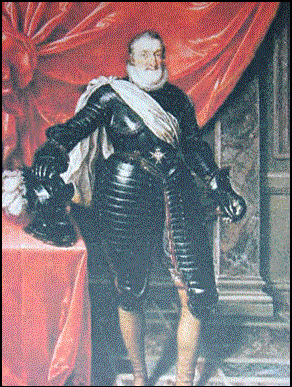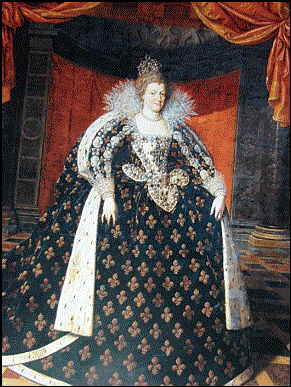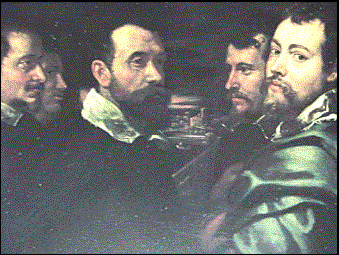No products
NEW BREMEN AND THE FLEMISH ARTISTS CONNECTION
By Dr. John T. Dickman - Columbus, Ohio
[originally published in the April 1995 issue of “The Towpath”]
Genealogies are always interesting, sometimes enlightening, and occasionally even shocking as we probe deeply into our dim ancestral past. This article is not intended to be one of those “who begat whom” genealogies with the kind of detail that is of interest only to an immediate family. Rather, it is an exploration of an intriguing connection between our little village of New Bremen and a family of significant Flemish artists who flourished in Europe throughout the 15th through 17th centuries.The suggestion of such a connection was first proposed and researched in the 1950s by the late Professor Elmer Ende, a New Bremen native son and Professor of Music and master of the organ at the University of Akron. Later, in the 1970s, Eugene Purpus of Tiberon, California, researched and wrote an extensive Purpus genealogy, beginning with an investigation of the family of Flemish painters, upon which this narrative is largely based.
The story begins in Gouda in the Netherlands, a thriving trade center still famous today for the round red balls of Gouda cheese. In this city in the mid-1500s lived an artist by the name of Pieter (Janz) Pourbus, born probably in 1523 or 1524. The spelling of the last name has varied over the years (Pourbus, Porbus, Porbis, Purbus, and several other variations), but Pourbus was the spelling adopted by the Gouda family until, as we shall see, around the beginning of the 17th century. Pieter, known as Pieter the Younger because his father’s name was also Pieter, was a painter of religious subjects, allegorical scenes and portraits. Examples of each now reside in numerous museums and churches throughout Europe.
As a portrait artist, he is judged today as having been somewhat “old fashioned” – the expression in the face of his subjects seemed less important to him than the elaborate detail and texture of the sitter’s decorative clothing and velvet drapery backgrounds. This trait seems to have been carried through the generations of Pourbus painters. But he was more than an artist. He was also a city planner and map maker for the cities of Bruges and Antwerp (in Flanders then, but known as Belgium today) where he mapped the depths of the coastal waters.
Pieter Pourbus the Younger died in Bruges in 1584, leaving a son, Frans Pourbus, who was born in Bruges in 1545 and whose artistic skills overshadowed those of his father. Frans was a student of his father and painted a wide range of subjects, including religious themes, wooded landscapes with animals and portraits. He was a Master in the Antwerp Guild and a free master of the Guild of St. Luke, which were important appointments for the successful artist of the day. His portraiture was much more alive than that of his father’s. His works are also displayed in Europe and in many museums throughout the world. Frans’ life was cut short when he died of typhoid fever in 1581 in Antwerp. But he left a son that was to become the most famous of the Pourbus family of painters – Frans the Younger.
Frans Pourbus the Younger was born in Antwerp in 1569. He was only twelve years old and living in Bruges when his father died. When Frans was nineteen, he inherited a sum of money from his grandmother (the wife of Pieter the Younger) and moved to Antwerp where he became a Guild Master in 1591. He rose to the rather lofty and prestigious position of court painter for the royal court of Archduke Albert of Brussels. It was there that he got his big break. In 1599 he was invited by Vincenzo Gonzaga, the Duke of Mantua, to become his court painter in Italy. So in 1600 Frans Pourbus the Younger went to Mantua where he was employed as court painter and contributor to the Duke’s gallery of beautiful women. But another event happened at Mantua that was to influence Frans’ life further. At about the same time the Duke employed another Flemish painter to his court, the soon-to-be world renowned Peter Paul Rubens. Pourbus and Rubens worked as colleagues from 1600 to 1608.
In 1609 Frans Pourbus was sent to Paris by the Duke of Mantua to do some painting for Henry IV of France and Queen Maria de Medici. The Queen specifically asked the Duke for the permanent services of Pourbus and the Duke agreed. One of his portraits of Marie de Medici hangs in the Chicago Art Institute and hundreds of examples of his works grace private collections and museums around the world. He did not rise to the eminence of his contemporary, Peter Paul Rubens, but his work is looked upon favorably by the art world. Van Puyvelde and Van Puyvelde, in their book Flemish Painting – The Age of Rubens and Van Dyke, published by McGraw Hill in 1970, offer the following assessment:
“To judge the true value of Frans Pourbus the Younger’s talent – and he had his moment of glory – one ought to compare his work with that of Rubens, who often painted the same people at the same time. Pourbus saw them in a static position, sometimes against a neutral background. He handled them attentively and to advantage, lingering more often on the decoration than on the expression of the character. Rubens, on the contrary, transposed them, surrounded them with atmosphere, and made them more alive and gave them more presence.”
One can see from this assessment that the characteristic of focus on decorative detail alluded to earlier did indeed carry over from grandfather Pieter, through father Frans I, to Frans II. There is evidence that he may have learned from Rubens to pay a little more attention to a subject’s face in his later works.
The religious persuasion of the Pourbus family was Protestant. It was during this time in history that great strife arose between the French Roman Catholics and a group of Protestant followers of John Calvin and the Reformed Church (Huguenots). It is believed that Pourbus himself did not outwardly proclaim his religious beliefs, but moved his family around 1615 away from this strife into the Rheinlandpfalz of western Germany, where the family name became, and remains to this day, the German version, Purpus. Frans himself returned to Paris and remained there as court painter until his death in Paris in 1622. And here begins the New Bremen connection.
The Purpus name was once quite prominent in New Bremen history. The family came to America, specifically to New Bremen, circa 1868 from the village of Lauterecken in the Rheinlandpfalz, the very location to which Frans Pourbus moved his family in 1615. The Purpus family history in Germany begins with a Johann Purpus, born in 1700 in Weinheim, a village in the Lauterecken area. Family genealogist Eugene R. Purpus wrote in 1977: “I have not yet been able to get firsthand documentation for the short period from 1615 to 1700, but I now have complete documentation for the direct line of German Purpuses who were descendants of the Flemish painters.”
Mr. Purpus is saying that although the period between 1615 and 1700 may require a slight leap of faith because genealogical documentation during that turbulent period is sparse or lacking, the existing evidence is more than adequate to complete the connection of which he speaks.
Johann’s grandson, Johann Ludwig Karl Purpus (b. 1808), immigrated to New Bremen from Lauterecken with at least three of his sons. The 1870 United States census records him as living next door to one of them. The sons included Eduard, who operated the “Ed Purpus Toy and Fancy Store” at the corner of Main and Monroe Streets and served as the town’s mayor in the later 1800s; Theodore, who was a school teacher and was the editor of New Bremen’s early newspaper Der Stern des Westlichen Ohio; and Ludwig (known in America as Louis), a schoolmaster who suffered a similar fate in America to that of his ancestor, Frans Pourbus the Elder, both dying of typhoid fever. Louis was the father of my grandfather, Fridolin T. Purpus, who was manager of the erstwhile New Bremen Broom Company and proprietor of the Purpus Insurance Agency, forerunner of the present-day New Bremen Insurance Agency, Inc.
Today no one bearing the Purpus name lives in New Bremen. However, the grandson of Theodore, the late Ted Purpus, lived in Minster and, like his great uncle Eduard, served several terms as mayor of his village. Ted’s two sons Don and Jay live in Minster to carry on the Purpus name. It seems that one of the characteristics of the Purpus family has been its proclivity to produce female offspring, which is disadvantageous in carrying on the family name.
So, from a family of Flemish painters to the New Bremen Purpuses, the connection is complete. Whether the present-day Purpuses carry any of the artistic talents of their forebears is unknown. However, it might be a good idea to scour the auctions and garage sales of New Bremen. Perhaps you might come up with a painting like that reported several years ago in Minneapolis. A religious painting had been donated to the Sunday School of the Hennepin United Methodist Church in Minneapolis in 1928. It served to decorate a wall, perhaps even hiding a crack, until in 1992 it was learned that the painting was the work of the 16th-century Flemish painter, Pieter Pourbus the Younger, and was valued at somewhere between $200,000 and $300,000!
Over the years I have assembled a collection of photographs, post cards, and reproductions of the works of the three generations of Pourbus painters from art museums and galleries around the world as well as from the Internet. To illustrate the artistic talent of the most famous of the Pourbus painters, here are photos of three reproductions of the paintings of Frans Pourbus The Younger.

This painting is of King Henry IV of France dressed in full armor. It hangs in the Louvre in Paris.

This is one of many portraits of Queen Maria de Medici that Frans Pourbus painted. It is from the Louvre and is probably Frans Pourbus' most famous portrait.

Finally, a very interesting painting, not by Pourbus, but by Peter Paul Rubens in which Rubens paints a self-portrait - he's on the right looking at the observer. The fellow in the center with the beard facing Rubens is believed by most scholars to be Frans Pourbus II. I saw the painting hanging in the Wallraf-Richartz Museum in Cologne and bought a slide from which this picture was taken.

